|
C茅line Sciamma’s new film Portrait of a Lady on Fire is like a visual poem that doesn’t explain itself. You are invited to decipher its intimate and often strongly symbolic tableaux in your own way. The many suspenseful turns of the story are best savored if you don’t know too much in advance.
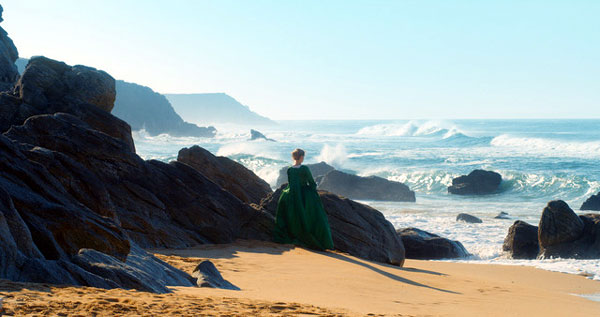
The film is about a late 18th century painter and her contract to paint the portrait of a young woman who refuses to be painted. The original French title calls her a young girl, une jeune fille en feu, a certain allusion to Proust’s Jeunes filles en fleur with its lesbian themes. The English version opted for the more familiar echo of the novel Portrait of a Lady by Henry James. It’s the fourth film by Sciamma distributed in America, (qv) a chamber piece for four women—the painter Marianne, the reluctant model H茅loise, her aristocratic mother, and the young maid Sophie. Their restricted life in the fire- and candle-lit rooms of a manor house in Brittany is set against a seashore with dangerous cliffs and rock formations. The sounds of sea and wind contrast with the stillness inside that is dominated by the crackling and spitting of fires in the ample fireplaces.
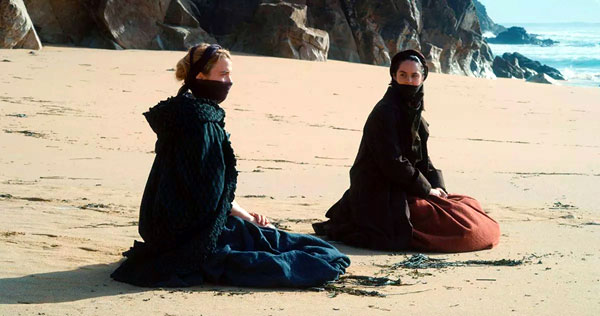
At the start of the movie, Marianne teaches painting to a small group of women students, posing as a model for them. One student has discovered a canvas that the teacher has painted “long ago”: a night scene with the figure of a woman in the background who seems to be on fire. The student learns that she had better not ask about this “long ago” piece of work—and the story begins as a flashback. What happened (in fact, not so long ago) is told without interruption until almost the end, when we return to Marianne’s present.
In just a few strokes, as we enter the past, we get the character of this painter: her dare-devil leap from a boat into the wintry sea to save her tools that have been swept overboard; her undeterred climb, wet as a dog, up the ragged cliff to the house; the freedom she takes, drying her canvasses and herself at the fire, smoking a pipe, naked.
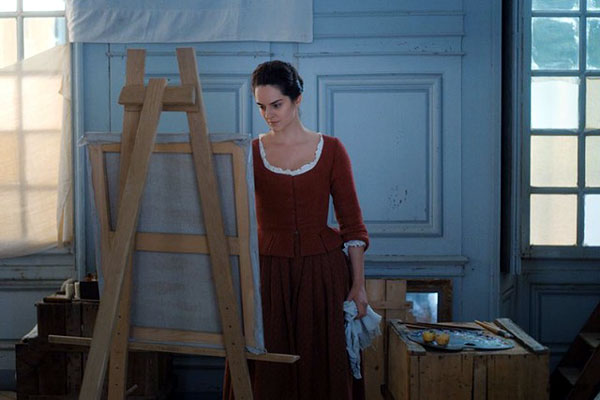
Marianne’s patroness, the mother, wants the portrait of her daughter to bring off a society wedding for her in Italy. The painting is what we would call a “sales ad.” Marianne has to paint it surreptitiously, under the guise of being a walking companion (and guardian) for the daughter. We get to know H茅loise only second-hand: Marianne learns that she was a convent girl until two weeks ago, when her older sister fell from the cliff at the edge of the property. A suicide, says the young maid Sophie who was right there. Marianne has six days to stealthily observe her subject and paint her from memory, while H茅loise is supposed not to notice. The audience has the suspense of discovering H茅loise at the same time the painter does, wondering if and how such a portrait can be created. What if H茅loise discovers the ruse? What if the sixth day leads to another suicide, perhaps by fire?
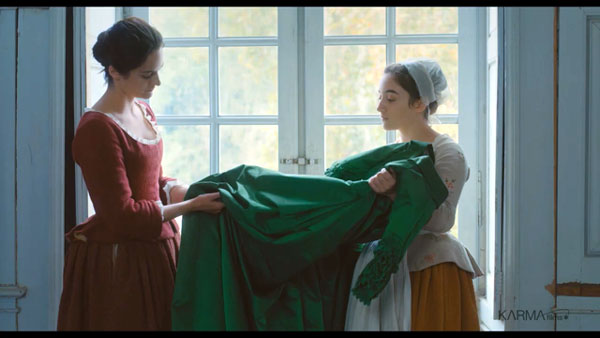
Marianne has been handed a sumptuous, emerald-green silk dress by Sophie, the only dress the convent girl owns, and Marianne puts it on, using her own mirror image to render the body in the dress. The camera watches the progress with great attention to detail. Marianne learns that another painter, a man, has already tried his hand at the task and left his canvas behind: a lady in a green dress with an empty space where her face should be. Marianne sets fire to his work, but this cocky act—of self-empowerment perhaps, or ritual possession— is premature.
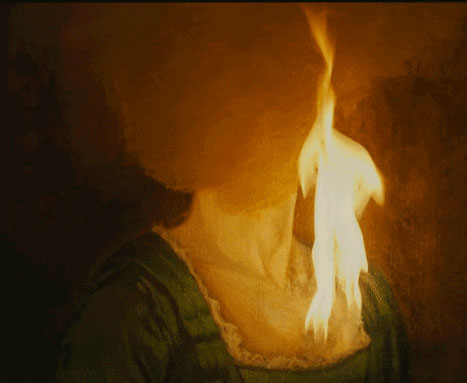
H茅loise sees the finished portrait a moment before her mother does, and rejects it out of hand. This isn’t a portrait of her, she challenges the artist; she isn’t present in this painting and neither, by the way, is Marianne! Marianne is piqued: “I didn’t know you were an art critic!” “I didn’t know you were a painter,” H茅loise shoots back. As the mother comes in, ready to take the portrait to Italy, Marianne wipes out the face she painted.
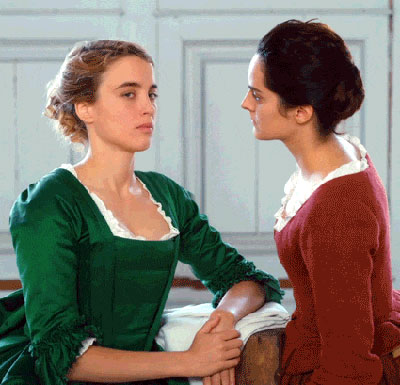
With the mother gone and the “sales ad” destroyed, H茅loise agrees to wear the dress and model for Marianne. Now there is the suspense of how the new painting will compare with the first one and how it will reflect the changing relationship between painter and model. To her surprise, Marianne finds out that H茅loise observes her with the same scrutiny and intelligence the artist applies. This moment, among the many scenes of looking and being looked at, highlights director Sciamma’s claim that her film is about the “female gaze”—by which she refers to a relationship between two subjects instead of the subject- object dynamics of the dominant “male gaze.”
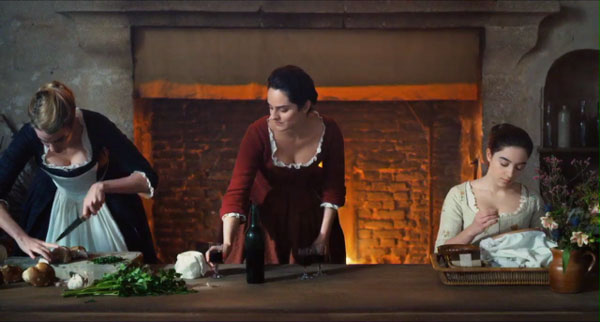
Now that the truth is out everything shifts. The house becomes the domain of an unlikely sisterhood— the artist, the convent girl and the maid. There is no servant, no master, no patron any more. Sophie is pregnant and we are shown in a number of stunning scenes how Marianne and H茅loise try to help her end her pregnancy. But the egalitarian energy extends even further. With a great emotional sweep the camera (by Claire Mathon) shows the three women setting out together into the night, striding with purpose and billowing cloaks to join the village women and the old crone who knows about unwanted pregnancies. They join their circle around a big fire, and a low chant rises as if from the throat of the earth. The women sing together in strange, edgy harmonies, accompanying themselves with rousing handclapping.
I was struck by the realization that there had been no background music in the entire film—nothing but the sounds of voices, steps, everyday objects, fire and wind. As the bewitching chant continues one recognizes the scene from Marianne’s “long ago” painting. It is the moment when Marianne and H茅loise recognize across the circle that they are in love, and H茅loise literally catches fire.
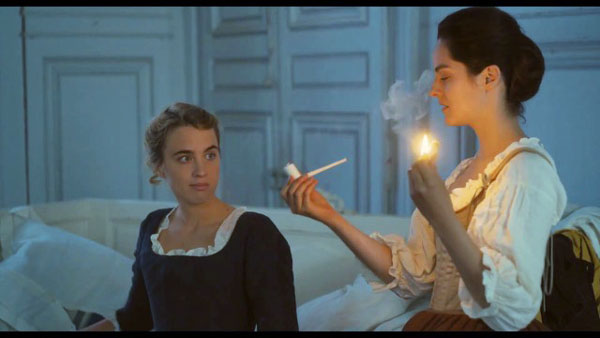
The love story is told as sparingly and sensuously as the entire film. A sudden close-up of a hand gliding into the flesh between H茅loise’s naked arm and breast is more shockingly intimate than the entire 6-minute scene of frantic sex positions in the notorious French movie Blue is the Warmest Color (by Abdellatif Kechiche). It’s as though Sciamma is challenging the voyeuristic gaze of our culture (including Jacque Rivette’s film La belle noiseuse from 1991 with Michel Piccoli as a painter and Emanuelle B茅art as his model), saying: You have no idea, guys, but I will give you a hint. (qv)
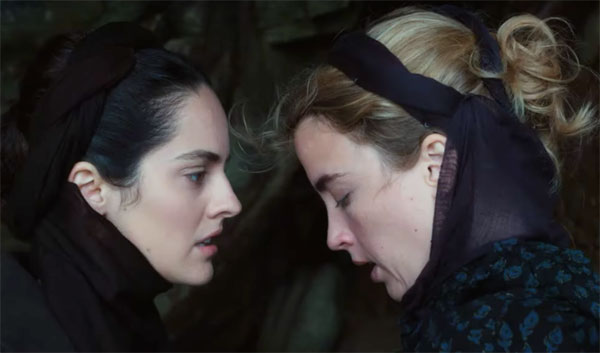
She takes the artist Marianne and her craft as seriously as German director van Donnersmarck did in his recent Never Look Away, the film about the painter Gerhard Richter that shows a young man becoming an artist. Sciamma shows an accomplished portraitist who revises her initial vision of a pretty lady and now captures the woman she loves, who looks back at her with a mixture of knowledge and anguish.
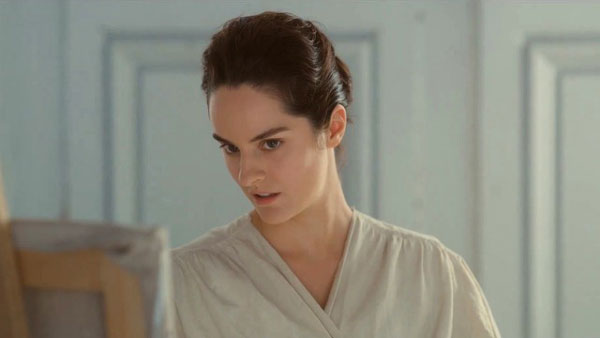
While the return of H茅loise’s mother threatens, the three women read the myth of Orpheus and Eurydice together and discuss its meaning. Sophie is indignant that Orpheus could be so irresponsible. Marianne disagrees. Orpheus turns around on purpose because he is an artist, a poet, and he prefers to keep the memory of his love. H茅loise disagrees with both: what if Eurydice calls Orpheus to turn around so she won’t have to follow him back into his world?
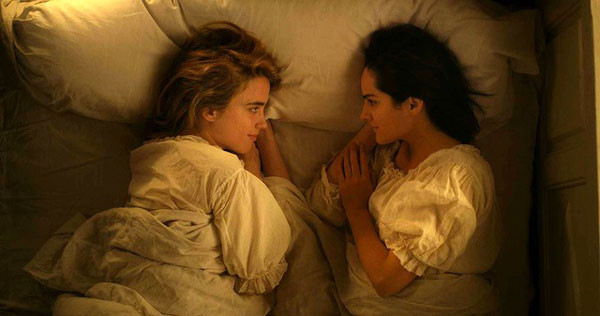
Here the writer/director gives us an idea on how the inevitable separation of the lovers may turn out. In their last intimate moment, when the mother has returned, H茅loise accuses Marianne of being angry at her for getting married. Marianne admits it is true. The audience has time to contemplate the alternatives while the two lovers are staring it in the face: a return to the convent, a suicide, or a societal scandal and poverty? “Would you like me to refuse?” H茅loise asks in a tone and expression that says, say yes and I am ready to destroy myself for you. Marianne’s simple “No” has the full awareness that she is betraying H茅loise while at the same time saving her.
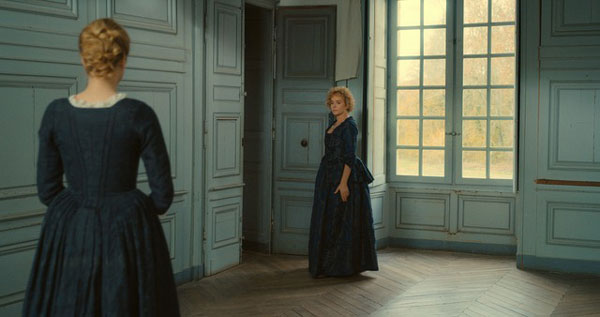
Both actresses, No茅mie Merlant (Marianne) and Ad猫le Hainel (H茅loise), are in high demand in France. According to the press, Haenel is the most sought-after movie actress of the moment (similar to Adam Driver in the US). They both got a Lumi猫re Award for this movie, and Haenel was nominated for a C茅sar (equivalent to the Oscar). Writer and director Sciamma won a C茅sar for Best Screenplay and a Queer Palm for her film.

Perhaps the most brilliant accomplishment of Sciamma as writer/director is to show her two seeingly incompatible heroines —a bohemian and a convent girl—as equals. The worldly wisdom of Marianne is met by a fiercely intelligent innocence in H茅loise, and Sciamma lets H茅loise’s passion for emotional truth run up against Marianne’s experience of Parisian life. (I wondered if Sciamma chose the name H茅loise as an homage to another brilliant convent girl in love, the 12th century story of Ab茅lard and H茅loise.)
H茅loise’s innocence embraces a radical freedom in her understanding of the world. She holds no judgment that would taint her love as a sin, and there is no conventional moral attitude that would stop her independent thinking. On the contrary, she takes the maid’s choice of not having her baby as self-evident. When she has witnessed Sophie`s abortion on the family bed of the village woman/ herbalist/midwife, she wants Marianne to paint it to bear witness. The three women restage the scene, with H茅loise posing as the abortionist. One could hardly imagine a more revelatory example of the “female gaze” for today’s audiences.
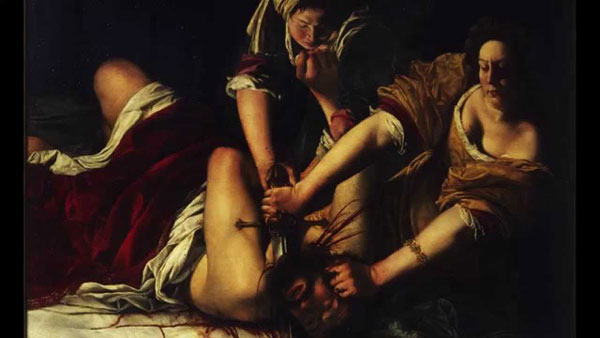
But the director also reaches back to the paintings of 17th century painter Artemisia Gentileschi, an early proponent of this way of looking at the world. At age 24, the Italian artist painted the most brutally honest version of the numerous classic depictions of Judith beheading Holofernes, assisted by her maid (Judith Slaying Holofernes, 1614-20). It seems to me that Sciamma wrote the character of Marianne like an homage to Artemisia, who was also taught by her father, forbidden to study male nudes, but doing it anyway on the sly, excluded from the canon and sometimes sailing incognito under the name of her father, Orazio Gentileschi. One could argue that even the painterly style of her film goes back to this source of inspiration and echoes the chiaro-scuro style of Artemisia’s often candle-lit scenes.
To come to the ending without giving it away:
Sciamma doesn’t tell us how the two women survive their separation —but she leaves us with a few fascinating clues. H茅loise has only heard organ music in her convent; she never heard an orchestra. Early in the story Marianne plays her a few notes from Vivaldi’s The Four Seasons on the spinet – and this section of Vivald’s concert, played full-out by an orchestra, will come to haunt both Marianne, H茅loise, and all of us.
* Waterlilies (2007), Tomboy (20011, Girlhood (2014)
** Quote from director C茅line Sciamma: “In France, they don’t find the film hot. They think it lacks flesh, it’s not erotic. It seems like there are some things that they can’t receive.”
See: https://www.theguardian.com/film/2020/feb/21/celine-sciamma-portrait-of-a-lady-on-fire
|